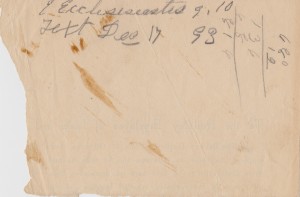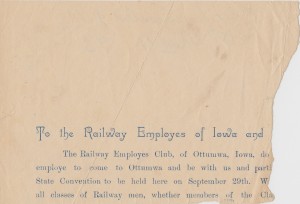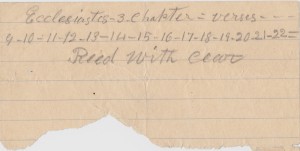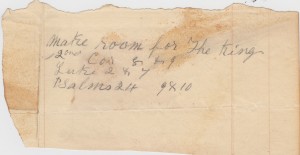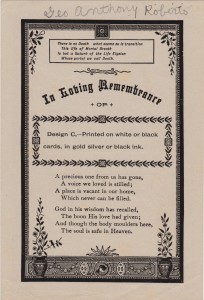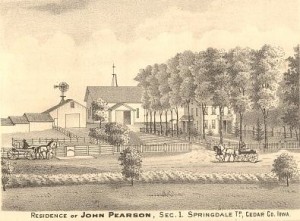Church Record Sunday: The Johns Family of Indiana

Roberts Family, Murrell Family (Click for Family Tree)
Last week we posted about a surprising find- that Matthias/Matthew Johns was buried in a Friends (Quaker) cemetery in Wilkinson, Hancock County, Indiana. It made us wonder who else in the family had become Quakers, with a special interest in Matthew’s father, Henry Honts, who is our direct ancestor.
Even though Quakers kept very good records, they have not all survived, or they may be in library collections that are only accessible in person. Apparently, as the number of Quakers decreased after the Civil War, and the population continued to move west, Monthly Meetings (MM) got smaller and were combined with others in the area. Wilkinson MM seems to be one of these, so records are a bit more challenging to find. We finally did find some with the Johns name, attached to the Raysville-Knightstown MM.
The names shown above, however, were not familiar, as the Johns family has not been a research focus except for Henry Honts, who changed the family name to Johns. so some collateral research was in order, to find out who these folks were, and how they were related. It made sense to start with Matthew’s family, but he did not have a son named William H. Johns. So research on his sons was next, and amazingly, Henry Johns (1844-1895), the first son, was the connection. (Of course, I had started with the youngest son instead…)
Henry Johns married Sarah J. Coon/Kuhn (1849-1903) and of the seven children found in that family, William H. Johns was the second-born, on 1 July 1869 in Wilkinson, Hancock County, Indiana. He was found in the 1870 and 1880 US Federal Censuses there with his parents and siblings. Some Ancestry.com trees state he married first Mary J. Henshaw in 1891 (Marriage Book 3, page 522 in Hancock Co., IN), then Florence Walker (Marriage Book C8, page 406) in 1892; getting copies of these marriage licenses could be a next step. The marriage we do have more sources for is to Bertha Corbin, as shown above. The 1900 US Federal Census has them listed together with their 3 year old daughter Mamie Esther Johns, and states they have been married for 3 years, thus married about 1897. It also states this was his second marriage.
In 1900 William H. was working as an engineer in a sawmill, and he had been employed all of the previous 12 months. They rented their home. Ten years later, William H. was listed as a machinist, and Bertha was working as a washerwoman. Their daughter Mamie Esther was listed with them, but no daughter named Martha Carol Johns- perhaps she died young?
By 1920, William and Bertha owned their home, mortgage-free, and he was working still as a machinist. Their daughter M. Esther was living with them, along with her husband, Walter Winn, and their daughter, Martha V. Winn. Walter was also a machinist, and worked at a “bottle house.”
Bertha passed away on 30 Aug 1925, and William was listed as widowed and a laborer in the “thresherman” industry in the 1930 census. He had not worked the previous day, however, and was listed on the unemployed schedule. He was 61. In 1940, he was still living on his own at age 71, and was not employed.
William died 11 May 1953 in Wilkinson, where he is also buried, alongside his wife Bertha in McCray Cemetery. The plaque in the cemetery states that a Baptist Church was first built on that spot, then later First Christian Church. It thus appears this is not a Friends cemetery, so had William abandoned the Quaker faith, had his children, or was it just more convenient to be buried with family nearby?
Notes, Sources, and References:
- How are we related? If you are a descendant of Edith (Roberts) [McMurray] Luck, her great-grandparents were Mary M. Honts and Wiley A. Murrell. Mary’s father was Henry Honts, who changed his name to Johns when he left his first wife and Mary in Virginia and moved to Tennessee. Matthew Johns was the son of Henry and his second wife, Elizabeth (Firestone) [Lampert] Johns, so Mary’s half-brother.
- “Abstracts of the Records of the Society of Friends in Indiana,” Births, Vol. 7, Part 4, available from FamilySearch– https://dcms.lds.org/delivery/DeliveryManagerServlet?dps_pid=IE190486
- Johns family members buried in McCray Cemetery, Wilkinson, Hancock County, Indiana– https://www.findagrave.com/cemetery/85847/memorial-search?firstName=&lastName=Johns&page=2#sr-28834638
- McCray Cemetery History- see plaque in images– https://www.findagrave.com/cemetery/85847/mccray-cemetery
- See also cemetery image for “The Elopement Girl” and the beginnings of the cemetery- so sad.
Click to enlarge any image. Please contact us if you would like an image in higher resolution.
We would love to read your thoughts and comments about this post (see form below), and thank you for your time! All comments are moderated, however, due to the high intelligence and persistence of spammers/hackers who really should be putting their smarts to use for the public good instead of spamming our little blog.Original content copyright 2013-2017 by Heritage Ramblings Blog and pmm.
Family history is meant to be shared, but the original content of this site may NOT be used for any commercial purposes unless explicit written permission is received from both the blog owner and author. Blogs or websites with ads and/or any income-generating components are included under “commercial purposes,” as are the large genealogy database websites. Sites that republish original HeritageRamblings.net content as their own are in violation of copyright as well, and use of full content is not permitted. Descendants and researchers MAY download images and posts to share with their families, and use the information on their family trees or in family history books with a small number of reprints. Please make sure to credit and cite the information properly. Please contact us if you have any questions about copyright or use of our blog material.SaveSave
SaveSave
SaveSave
SaveSave
SaveSave



